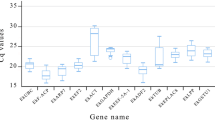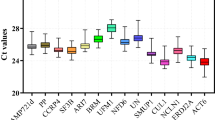Abstract
Understanding into acerola (Malpighia emarginata) molecular and biochemical bases is still obscure, despite it is one of the most important natural source of vitamin C for humans. Recently, our research group published the first data on acerola transcriptome generating valuable information to identify reference genes for RT-qPCR in this species. Hence, this study aimed to identify the most stably expressed genes based on acerola transcriptome data, and further to evaluate the suitability of F-box, U3, Merad50-ATPase, TGD4, NOB1, PA-RNA, RCC1, RBL and PGAL candidates for accurate gene expression normalization in leaf, flower and fruit at 12, 16 and 20 days after anthesis using RT-qPCR analysis. Three algorithms, geNorm, NormFinder, and BestKeeper confirmed the expression stability of all nine candidate reference genes, whereas RefFinder consensually summarized a comprehensive gene ranking. Based on geNorm, the combination of the most stable reference genes RBL and U3 for leaf/flower group, TGD4, F-box and PGAL (fruit developmental stages or fruit/leaf), RCC1, PGAL and RBL (fruit/flower) and RCC1, RBL, TGD4 and PGAL (total samples) were required for accurate normalization. Moreover, the use of these reference genes to assess the expression profile of GMP1 and NAT3 genes confirmed the reliability of ranking and defined the best combination of genes recommended by geNorm and RefFinder. This work will benefit further RT-qPCR studies in these acerola organs by offering a foundation for accurate normalization of gene expression profiling.





Similar content being viewed by others
References
Andersen CL, Jensen JL, Ørntoft TF (2004) Normalization of real-time quantitative reverse transcription-PCR data: a model-based variance estimation approach to identify genes suited for normalization, applied to bladder and colon cancer data sets. Cancer Res 64:5245–5250. https://doi.org/10.1158/0008-5472.CAN-04-0496
Badejo AA, Esaka M, Jeong ST, Goto-Yamamoto N (2007) Molecular cloning and expression of GDP-d-mannose-3,5-epimerase during fruit ripening in acerola. Acta Hortic 763:91–98. https://doi.org/10.17660/ActaHortic.2007.763.12
Badejo AA, Fujikawa Y, Esaka M (2009) Gene expression of ascorbic acid biosynthesis related enzymes of the Smirnoff-Wheeler pathway in acerola (Malpighia glabra). J Plant Physiol 166:652–660. https://doi.org/10.1016/j.jplph.2008.09.004
Badejo AA, Jeong ST, Goto-Yamamoto N, Esaka M (2007) Cloning and expression of GDP-d-mannose pyrophosphorylase gene and ascorbic acid content of acerola (Malpighia glabra L.) fruit at ripening stages. Plant Physiol Biochem 45:665–672. https://doi.org/10.1016/j.plaphy.2007.07.003
Badejo AA, Tanaka N, Esaka M (2008) Analysis of GDP-d-mannose pyrophosphorylase gene promoter from acerola (Malpighia glabra) and increase in ascorbate content of transgenic tobacco expressing the acerola gene. Plant Cell Physiol 49:126–132. https://doi.org/10.1093/pcp/pcm164
Badejo AA, Wada K, Gao Y et al (2012) Translocation and the alternative d-galacturonate pathway contribute to increasing the ascorbate level in ripening tomato fruits together with the d-mannose/L-galactose pathway. J Exp Bot 63:229–239. https://doi.org/10.1093/jxb/err275
Bustin SA, Benes V, Nolan T, Pfaffl MW (2005) Quantitative real-time RT-PCR—a perspective. J Mol Endocrinol 34:597–601. https://doi.org/10.1677/jme.1.01755
Carrington CMS, King RAG (2002) Fruit development and ripening in Barbados cherry, Malpighia emarginata DC. Sci Hortic (Amsterdam) 92:1–7. https://doi.org/10.1016/S0304-4238(01)00268-0
Chang SK, Alasalvar C, Shahidi F (2018) Superfruits: phytochemicals, antioxidant efficacies, and health effects—a comprehensive review. Crit Rev Food Sci Nutr. https://doi.org/10.1080/10408398.2017.1422111
Chen L, Hying Z, Kuang JF et al (2011) Validation of reference genes for RT-qPCR studies of gene expression in banana fruit under different experimental conditions. Planta 234:377–390. https://doi.org/10.1007/s00425-011-1410-3
Cheng Y, Bian W, Pang X et al (2017) Genome-wide identification and evaluation of reference genes for quantitative RT-PCR analysis during tomato fruit development. Front Plant Sci 8:1–13. https://doi.org/10.3389/fpls.2017.01440
Cheng Y, Pang X, Wan H et al (2017) Identification of optimal reference genes for normalization of qPCR analysis during pepper fruit development. Front Plant Sci 8:1–14. https://doi.org/10.3389/fpls.2017.01128
Costa JH, Saraiva KDC, Morais VD et al (2016) Reference gene identification for real-time PCR analyses in soybean leaves under fungus (Cercospora kikuchii) infection and treatments with salicylic and jasmonic acids. Australas Plant Pathol 45:191–199. https://doi.org/10.1007/s13313-016-0403-x
Czechowski T, Stitt M, Altmann T et al (2005) Genome-wide identification and testing of superior reference genes for transcript normalization in Arabidopsis thaliana. Plant Physiol 139:5–17. https://doi.org/10.1104/pp.105.063743.1
de Assis SA, Pedro Fernandes F, Martins ABG, de Faria Oliveira OMM (2008) Acerola: importance, culture conditions, production and biochemical aspects. Fruits. https://doi.org/10.1051/fruits:2007051
Dekkers BJW, Willems L, Bassel GW et al (2012) Identification of reference genes for RT-qPCR expression analysis in arabidopsis and tomato seeds. Plant Cell Physiol 53:28–37. https://doi.org/10.1093/pcp/pcr113
Delva L, Schneider RG (2013) Acerola (Malpighia emarginata DC): production, postharvest handling, nutrition, and biological activity. Food Rev Int 29:107–126. https://doi.org/10.1080/87559129.2012.714433
dos Santos CP, Batista MC, Saraiva KDC et al (2019) Transcriptome analysis of acerola fruit ripening: insights into ascorbate, ethylene, respiration and softening metabolisms. Plant Mol Biol 101:269–296. https://doi.org/10.1007/s11103-019-00903-0
Eltelib HA, Badejo AA, Fujikawa Y, Esaka M (2011) Gene expression of monodehydroascorbate reductase and dehydroascorbate reductase during fruit ripening and in response to environmental stresses in acerola (Malpighia glabra). J Plant Physiol 168:619–627. https://doi.org/10.1016/j.jplph.2010.09.003
Expósito-Rodríguez M, Borges AA, Borges-Pérez A, Pérez JA (2008) Selection of internal control genes for quantitative real-time RT-PCR studies during tomato development process. BMC Plant Biol 8:1–12. https://doi.org/10.1186/1471-2229-8-131
Fang Z, Cui X (2011) Design and validation issues in RNA-seq experiments. Brief Bioinform 12:280–287. https://doi.org/10.1093/bib/bbr004
Ferradás Y, Rey L, Martínez Ó et al (2016) Identification and validation of reference genes for accurate normalization of real-time quantitative PCR data in kiwifruit. Plant Physiol Biochem 102:27–36. https://doi.org/10.1016/j.plaphy.2016.02.011
Ferreira DF (2014) Sisvar: a guide for its bootstrap procedures in multiple comparisons. Cienc e Agrotecnologia 38:109–112. https://doi.org/10.1590/S1413-70542014000200001
Gachomo EW, Jimenez-Lopez JC, Baptiste LJ, Kotchoni SO (2014) GIGANTUS1 (GTS1), a member of Transducin/WD40 protein superfamily, controls seed germination, growth and biomass accumulation through ribosome-biogenesis protein interactions in Arabidopsis thaliana. BMC Plant Biol 14:1–17. https://doi.org/10.1186/1471-2229-14-37
Galli V, Borowski JM, Perin EC et al (2015) Validation of reference genes for accurate normalization of gene expression for real time-quantitative PCR in strawberry fruits using different cultivars and osmotic stresses. Gene 554:205–214. https://doi.org/10.1016/j.gene.2014.10.049
González-Agüero M, García-Rojas M, Di Genova A et al (2013) Identification of two putative reference genes from grapevine suitable for gene expression analysis in berry and related tissues derived from RNA-Seq data. BMC Genomics. https://doi.org/10.1186/1471-2164-14-878
Gutierrez L, Mauriat M, Guénin S et al (2008) The lack of a systematic validation of reference genes: a serious pitfall undervalued in reverse transcription-polymerase chain reaction (RT-PCR) analysis in plants. Plant Biotechnol J 6:609–618. https://doi.org/10.1111/j.1467-7652.2008.00346.x
Hellemans J, Mortier G, De Paepe A et al (2007) qBase relative quantification framework and software for management and automated analysis of real-time quantitative PCR data. Genome Biol 8:R19. https://doi.org/10.1186/gb-2007-8-2-r19
Hu M, Hu W, **a Z et al (2016) Validation of reference genes for relative quantitative gene expression studies in Cassava (Manihot esculenta Crantz) by using quantitative real-time PCR. Front Plant Sci 7:1–12. https://doi.org/10.3389/fpls.2016.00680
Huang T, Long J, Liu SW et al (2018) Selection and validation of reference genes for mRNA expression by quantitative real-time PCR analysis in Neolamarckia cadamba. Sci Rep 8:1–11. https://doi.org/10.1038/s41598-018-27633-5
Huggett J, Dheda K, Bustin S, Zumla A (2005) Real-time RT-PCR normalisation; strategies and considerations. Genes Immun 6:279–284. https://doi.org/10.1038/sj.gene.6364190
Ibort P, Molina S, Ruiz-Lozano JM, Aroca R (2018) Involvement of a never ripe receptor in the interaction between two beneficial soil bacteria and tomato plants under well-watered and drought conditions. Mol Plant Microbe Interact 31:633–650. https://doi.org/10.1094/MPMI-12-17-0292-R
Jain M, Nijhawan A, Tyagi AK, Khurana JP (2006) Validation of housekee** genes as internal control for studying gene expression in rice by quantitative real-time PCR. Biochem Biophys Res Commun 345:646–651. https://doi.org/10.1016/j.bbrc.2006.04.140
Joseph JT, Poolakkalody NJ, Shah JM (2018) Plant reference genes for development and stress response studies. J Biosci 43:173–187. https://doi.org/10.1007/s12038-017-9728-z
Kodama M, Brinch-Pedersen H, Sharma S et al (2018) Identification of transcription factor genes involved in anthocyanin biosynthesis in carrot (Daucus carota L.) using RNA-Seq. BMC Genomics 19:1–13. https://doi.org/10.1186/s12864-018-5135-6
Kong Q, Gao L, Cao L et al (2016) Assessment of suitable reference genes for quantitative gene expression studies in melon fruits. Front Plant Sci 7:1–10. https://doi.org/10.3389/fpls.2015.01259
Kou X, Zhang L, Yang S et al (2017) Selection and validation of reference genes for quantitative RT-PCR analysis in peach fruit under different experimental conditions. Sci Hortic (Amsterdam) 225:195–203. https://doi.org/10.1016/j.scienta.2017.07.004
Kozera B, Rapacz M (2013) Reference genes in real-time PCR. J Appl Genet 54:391–406. https://doi.org/10.1007/s13353-013-0173-x
Kudo T, Sasaki Y, Terashima S et al (2016) Integrated brond band communication systems in Belgium identification of reference genes for quantitative expression analysis using large-scale RNA-seq data of Arabidopsis thaliana and model crop plants. Genes Genet Syst 91:111–125. https://doi.org/10.1109/JSAC.1986.1146346
Marshall OJ (2004) PerlPrimer: cross-platform, graphical primer design for standard, bisulphite and real-time PCR. Bioinformatics 20:2471–2472. https://doi.org/10.1093/bioinformatics/bth254
Maurino VG, Grube E, Zielinski J et al (2006) Identification and expression analysis of twelve members of the nucleobase-ascorbate transporter (NAT) gene family in Arabidopsis thaliana. Plant Cell Physiol 47:1381–1393. https://doi.org/10.1093/pcp/pcl011
Oliveira LDS, Moura CFH, De Brito ES et al (2012) Antioxidant metabolism during fruit development of different acerola (Malpighia emarginata D.C) clones. J Agric Food Chem 60:7957–7964. https://doi.org/10.1021/jf3005614
Perini P, Pasquali G, Margis-Pinheiro M et al (2014) Reference genes for transcriptional analysis of flowering and fruit ripening stages in apple (Malus × domestica Borkh.). Mol Breed 34:829–842. https://doi.org/10.1007/s11032-014-0078-3
Pfaffl MW, Tichopad A, Prgomet C, Neuvians TP (2004) Determination of most stable housekee** genes, differentially regulated target genes and sample integrity: BestKeeper©—Excel spreadsheet tool using a repeated pair-wise correlation and regression analysis. Biotechnol Lett. https://doi.org/10.1111/j.1582-4934.2008.00395.x
Prakash A, Baskaran R (2018) Acerola, an untapped functional superfruit: a review on latest frontiers. J Food Sci Technol 55:3373–3384. https://doi.org/10.1007/s13197-018-3309-5
Roston RL, Gao J, Murcha MW et al (2012) TGD1, -2, and -3 proteins involved in lipid trafficking form ATP-binding cassette (ABC) transporter with multiple substrate-binding proteins. J Biol Chem 287:21406–21415. https://doi.org/10.1074/jbc.M112.370213
Saraiva KDC, Fernandes de Melo D, Morais VD et al (2014) Selection of suitable soybean EF1α genes as internal controls for real-time PCR analyses of tissues during plant development and under stress conditions. Plant Cell Rep 33:1453–1465. https://doi.org/10.1007/s00299-014-1628-1
Vandesompele J, De Preter K, Pattyn F et al (2002) Accurate normalization of real-time quantitative RT-PCR data by geometric averaging of multiple internal control genes. Genome Biol. https://doi.org/10.1186/gb-2002-3-7-research0034
Wang Z, Anderson NS, Benning C (2013) The phosphatidic acid binding site of the arabidopsis trigalactosyldiacylglycerol 4 (TGD4) protein required for lipid import into chloroplasts. J Biol Chem 288:4763–4771. https://doi.org/10.1074/jbc.M112.438986
Yeap WC, Loo JM, Wong YC, Kulaveerasingam H (2014) Evaluation of suitable reference genes for qRT-PCR gene expression normalization in reproductive, vegetative tissues and during fruit development in oil palm. Plant Cell Tissue Organ Cult 116:55–66. https://doi.org/10.1007/s11240-013-0382-3
Zhang C, Huang J, Li X (2016) Transcriptomic analysis reveals the metabolic mechanism of L-ascorbic acid in Ziziphus jujuba Mill. Front Plant Sci 7:1–11. https://doi.org/10.3389/fpls.2016.00122
Zhang L, He LL, Fu QT, Xu ZF (2013) Selection of reliable reference genes for gene expression studies in the biofuel plant Jatropha curcas using real-time quantitative PCR. Int J Mol Sci 14:24338–24354. https://doi.org/10.3390/ijms141224338
Zhang Y, Peng X, Liu Y et al (2018) Evaluation of suitable reference genes for qRT-PCR normalization in strawberry (Fragaria × ananassa) under different experimental conditions. BMC Mol Biol 19:1–10. https://doi.org/10.1186/s12867-018-0109-4
Funding
This research was supported by CNPq, CAPES, and FUNCAP. CPS acknowledge doctoral grants from CNPq. JHC is grateful to CNPq for the Researcher fellowship (CNPq Grant 309795/2017-6).
Author information
Authors and Affiliations
Contributions
CPS, KDCS, and JHC conceived and designed research. CPS, KDCS and, TAG performed the experiments. CPS, KDCS, and MCB analyzed data. CPS wrote the manuscript. All authors read, commented on, and approved the manuscript.
Corresponding author
Ethics declarations
Conflict of interest
The authors have no conflict of interest to declare.
Additional information
Publisher's Note
Springer Nature remains neutral with regard to jurisdictional claims in published maps and institutional affiliations.
Electronic supplementary material
Below is the link to the electronic supplementary material.
Rights and permissions
About this article
Cite this article
dos Santos, C.P., da Cruz Saraiva, K.D., Batista, M.C. et al. Identification and evaluation of reference genes for reliable normalization of real-time quantitative PCR data in acerola fruit, leaf, and flower. Mol Biol Rep 47, 953–965 (2020). https://doi.org/10.1007/s11033-019-05187-7
Received:
Accepted:
Published:
Issue Date:
DOI: https://doi.org/10.1007/s11033-019-05187-7




